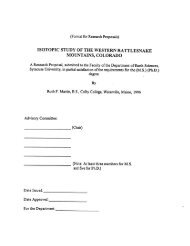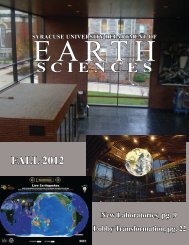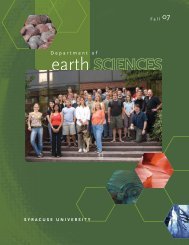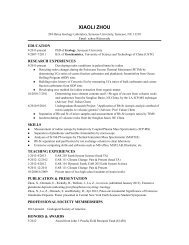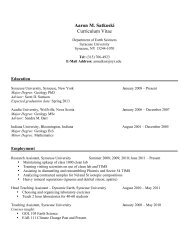alumni reception - Syracuse Universe Department of Earth Sciences ...
alumni reception - Syracuse Universe Department of Earth Sciences ...
alumni reception - Syracuse Universe Department of Earth Sciences ...
Create successful ePaper yourself
Turn your PDF publications into a flip-book with our unique Google optimized e-Paper software.
advisor, Pr<strong>of</strong>essor Linda Ivany, and I have modified<br />
these methods specifically for this project. Our<br />
research involves the application <strong>of</strong> these modern<br />
techniques to prehistoric whale taxa. For instance, we<br />
are looking at growth banding in the teeth <strong>of</strong> these<br />
whales. These bands represent changes in the rate <strong>of</strong><br />
dental hard tissue accumulation, are associated with<br />
seasonal phenomena, and can thus be used to estimate<br />
age. This technique was developed in the late 1950’s<br />
and is currently the most accurate method <strong>of</strong> aging<br />
stranded sperm whales, as their teeth grow continually<br />
and thus provide a record <strong>of</strong> lifespan. My advisor<br />
and I have adapted this method for use in these early<br />
whales with the goal <strong>of</strong> reconstructing the age makeup<br />
<strong>of</strong> the prehistoric Atlantic coastal plain populations.<br />
To this end we section the teeth longitudinally to view<br />
banding patterns. We are in the process <strong>of</strong> exploring<br />
Mandible and teeth <strong>of</strong> a prehistoric sperm whale (genus:<br />
Physeterula) from the Lee Creek Mine, North Carolina.<br />
Though smaller than their modern relatives, these whales<br />
were probably more deliberate predators, apparently<br />
feeding on fish and smaller whales as indicated by wear<br />
faceting on the teeth. The abundance <strong>of</strong> remains at<br />
the mine suggests it played some important ecologically<br />
role to these whales.<br />
a new promising technique: micro-computed<br />
tomography (Micro-CT). Micro-CT scanners use X-<br />
rays to take high resolution cross sections <strong>of</strong> objects,<br />
the X-rays detect minute density differences in the<br />
scanned object which manifest in the images as<br />
discreet features, and these density discrepancies can<br />
then be quantified and graphed. Contiguous growth<br />
bands have significantly different densities; hence<br />
theoretically this technique can be used to count<br />
growth bands and age our whales. Moreover, because<br />
the X-rays can easily resolve the internal features <strong>of</strong><br />
the teeth, sectioning is precluded.<br />
We are also interested in tooth chemistry,<br />
which may be used as a proxy for ecology. Teeth<br />
record the conditions at hand during their formation.<br />
Chemical signatures in teeth can represent certain<br />
characteristics <strong>of</strong> the environment or be indicative<br />
<strong>of</strong> particular biological and/or behavioral traits.<br />
With the proper tools to extract these signatures and<br />
understanding <strong>of</strong> their dynamics it is possible to<br />
reconstruct environmental parameters or determine<br />
the biological/behavioral inclinations <strong>of</strong> an organism.<br />
In this study we are attempting to determine whether<br />
or not these whales were migratory groups, looking<br />
specifically at carbon isotopes.<br />
I am tremendously grateful to all the programs<br />
that are helping to fund, not only this research, but<br />
my scholarship. They are: The Eastern Federation<br />
<strong>of</strong> Mineralogical and Lapidary Society, The<br />
Paleontological Society’s Stephen Jay Gould Student<br />
Research Grant, the National Science Foundation’s<br />
Graduate Research Fellowship, and The McNair<br />
Scholars fellowship, as well as contributions from<br />
The <strong>Syracuse</strong> University Office <strong>of</strong> Research and<br />
the Graduate School. I would also like to thank<br />
my advisor, Linda Ivany, for being a great mentor,<br />
colleague, resource and friend. I again sincerely<br />
extend thanks to all these programs and people,<br />
without which this research would not be possible.<br />
Nathan Graber<br />
I came to <strong>Syracuse</strong> University to start my<br />
Masters last fall. Since my arrival I have worked<br />
towards completing my thesis research and have<br />
made a great deal <strong>of</strong> progress towards completing my<br />
sample analysis. For my project I will use (U-Th)/He<br />
thermochronology on apatite as well as DEM analysis,<br />
to study the uplift history <strong>of</strong> the Frontal Cordillera <strong>of</strong><br />
the Andes, near Mendoza Argentina.<br />
I completed my field work, in Argentina, last<br />
January. While there I collected two suites <strong>of</strong> rock<br />
samples. Each set <strong>of</strong> samples consists <strong>of</strong> a vertical<br />
transect spanning approximately 2,500 meters <strong>of</strong><br />
elevation change. The samples I collected come from<br />
the Rio Mendoza and the Rio Tunuyan, river valleys.<br />
These samples will help constrain the timing <strong>of</strong> uplift<br />
by indicating when erosion significantly increased.<br />
This summer has been spent preparing the<br />
samples I collected in Argentina to run helium<br />
analysis. This preparation consists <strong>of</strong> crushing and<br />
sieving my samples before separating the minerals<br />
on the basis <strong>of</strong> density, using LST. Finally I will<br />
hand-pick apatite crystals which fit the specifications



